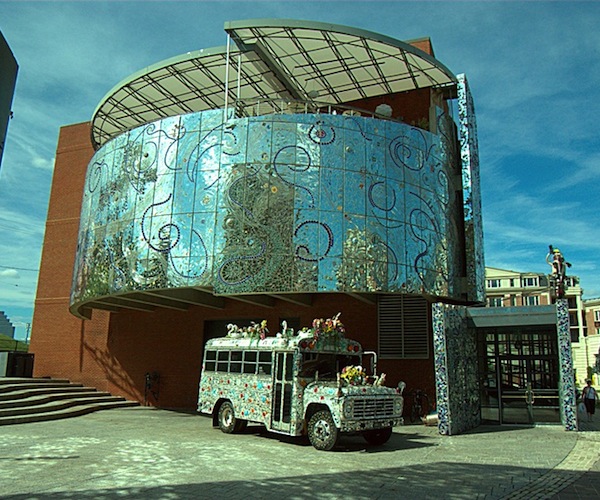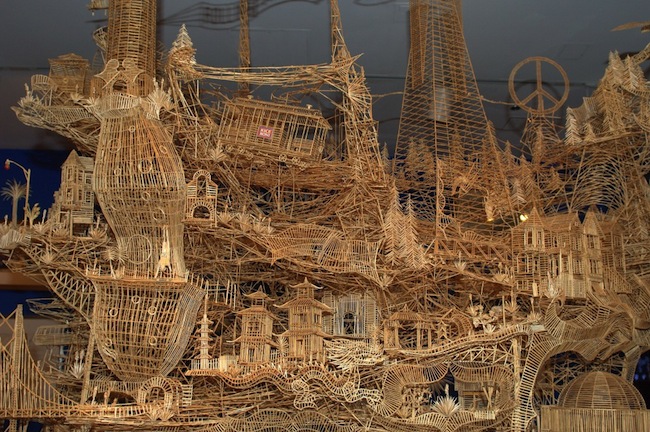Arts Commentary: Baltimore’s American Visionary Art Museum Envisions the Future — Now
To call the American Visionary Art Museum quirky would be an understatement: therein lies its charm as well as one of the reason for its success, even in economic hard times.

The American Visionary Art Museum in Baltimore, MD.
By Robert Israel
In Museums and the Pulse of the Future, a report by the American Alliance of Museums (AAM), director Elizabeth Merritt penned these prophetic words:
“All aspects of our world—social, technological, environmental, economic, political—are changing so quickly that museums need to add some long-term forecasting to their portfolio of planning skills.”
While the report emphasizes that traditional sources of financial support for museums have all but dried up, the AAM also states there are other revenue streams available. Getting to them, they say, requires embracing bold initiatives and pushing past cultural boundaries.
Museums are under constant pressure to mount new exhibitions even in the face of shrinking (or vanishing) government and foundation support. The current cash strapped climate creates an intense and highly competitive marketplace , with museums scrambling for limited funding. It is with this challenge in mind that Merritt’s statement about the necessity of preparedness — and the urgency to enact bold approaches to remain solvent in the face of all things seen and unseen – warrants a closer look.
AAM mentioned Boston’s Museum of Fine Arts as a case in point, referring specifically to when the MFA was served with a tax bill from the City of Boston a few years ago.
“The MFA, which already made a voluntary payment of $66,000 in 2011, was asked to pay more than $250,000 in 2012 and [will be asked to pay] more than $1 million a year by 2016,” the AAM report noted.
The MFA counter-proposed a payment-in-lieu-of-tax proposal (PILOT) based on a fixed rate multiplied by the number of museum visitors. But Boston’s PILOT taskforce rejected it, a decision, AAM says, that not only affected the MFA, but all of Boston’s museums.
The MFA has worked hard to recoup this drain on their coffers. A few of the strategies they have made use of in recent years: they’ve invited in oddball Boston-area collectors such as millionaire playboy William Ingraham “Bill” Koch (who displayed his America’s Cup trophy alongside a Picasso painting from his collection); tossed alcohol-fueled “mixers” for singles on Friday nights; held music concerts in the courtyard; initiated an expanded film series; started up a new restaurant for elegant dining; wooed young upstarts to join various social and fundraising committees.
AAM has bolder ideas in mind. It calls one of these, “Takin’ it to the Streets,” making art more immediate and more accessible in city neighborhoods. Another initiative, “The New Educational Era,” involves developing educational and outreach efforts (offsite classes, lectures, non-residency online learning programs) that generate revenue.
Some museums are already galloping forward. Examples include San Francisco’s Mobile Museum’s fleets of “art vans” whose exhibits sit in the back of cars; or Detroit Institute of Arts’ “Inside/Out Initiative,” in which replicas of paintings from their collection were placed on the sides of buildings in 11 cities throughout Michigan to entice new visitors to their downtown Detroit location. Museums like the Smithsonian and the British Museum have hired “Wikipedians in residence,” (they are also called “curators of community engagement”), whose jobs are to provide social media and online information sites like Wikipedia with a steady diet of digitized morsels. AAM believes museums can “harness the crowds” with these efforts, ultimately breaching the current financial malaise.
It was with the AAM report in mind that I recently visited Baltimore’s American Visionary Art Museum (AVAM), which, out of necessity, began mining these very sources for support almost twenty years ago. AVAM’s founding director, Rebecca A. Hoffberger, has personally shepherded the museum through all of its incarnations and has launched a number of ‘people-friendly’ initiatives.

Scott Weaver’s “Rolling Through the Bay” — a personal tribute to San Francisco that he began crafting in the 4th grade. Photo: Paul N. Jean.
AVAM is located a short walk from Baltimore’s Inner Harbor on an acre and a half of land. There’s a main building and adjacent structures that once served as a nineteenth century distillery. The museum’s backside literally hugs Federal Hill, where you can hike up stone steps for an unencumbered view of downtown and the harbor. During the summer months the museum takes advantage of the natural amphitheater formed by the adjacent sloping hillside; since 2005 up to 2,000 people have enjoyed its free “Flicks on the Hill” series.
To call the museum quirky would be an understatement: therein lies its charm.
It defines itself “America’s official national museum and education center for self-taught and intuitive artistry.” IT lives up to this statement by encouraging hands-on learning (in a workshop area designated for creativity) and by displaying an odd (to say the least) collection of homemade art by workers, famers, psychic mediums, and others.
“The museum was founded in the 1980s with the idea we could raise funds, keep costs to a bare minimum, and make use of all-volunteer staff,” Hoffberger told me.
The inaugural $7.6 million campaign was funded from private foundations and some public grants, including funders Anita and Gordon Roddick, founders of the U.K.-based The Body Shop. Hoffberger’s husband, co-founder LeRoy Hoffberger, sold off his personal collection of Expressionist art and donated the proceeds to the museum.
From the start, the AVAM embraced the notion of “takin’ it to the streets,” in 1999 launching a Kinetic Sculpture Race that has become one of the most beloved outdoor arts events in Baltimore. Each spring the city-wide event is led by a 13-foot tall, human powered, twin-seated sculpture called Fifi the Pink Poodle, housed permanently in AVAM’s warehouse. Designed by Theresa Segreti, this garish sculpture joyously celebrates the museum’s free spirited vision, wending its way through Baltimore’s streets, ending its journey with a splashdown in the Inner Harbor.
Fifi the Pink Poodle is but one of the many delights found within the museum. Another is the 55-foot tall whirligig that towers above the museum’s main building. Designed and built by 76-year-old farmer/artist Vollis Simpson and erected in 1995, it is titled, “Life, Liberty and the Pursuit of Happiness.” Its red, white, and blue spangles make for a very colorful display. Declared artist Simpson upon installing it in Baltimore: “I had a lotta junk and I had to do something with it.”
Hoffberger emphasizes this is all part of the museum’s “sure-fire recipe for enchantment.”
“It’s all about community based-programming that makes a difference,” she says. “Theme-related film series, festivals, conferences, plus creating fabulous opportunities for grassroots communal play. Never bore – always enchant!”

A glimpse of Fifi the Pink Poodle heading into the Baltimore’s Inner Harbor during the Kinetic Sculpture Race.
Even the outside wall of the museum seems to reflect this mission; it is composted of thousands of mirrors that face Key Highway. On April 18th a workshop with artist Bob Benson will teach (for a small fee) members and non-members how to cut and assemble mirrors, marbles, and such to create their own decorations.
Wandering through the galleries at AVAM, one quickly realizes how skillfully Hoffberger has integrated a number of elements and themes – history, science, social justice, rock music lyrics, assemblages, etc – into a funky and fascinating collage of images that one can actually touch and interact with. A bust made out of matchsticks, designed by Gerald Hawkes, is entitled “My Beccy: Woman of the Year.” There is a permanent collection of mechanical devices in a room Hoffberger calls the Cabaret Mechanical Theatre, where pressing buttons activates various machines, allowing viewers to see how they work. And there is an car with its trunk removed: the vehicle is filled with relics of the departed.
“We had a number of heroin related deaths in Baltimore one year, and my staff, several of them who had been heroin users, wanted to show the devastation that comes with drug abuse,” Hoffberger explained.
Leaving the museum after a tour, I watched as hordes of visitors made their way down the corridor to shop in “Sideshow,” a gift shop that sells gewgaws, masks, cheap plastic trinkets, as well as a smattering of frisky publications (“adults only” reads the sign). AVAM is at once a fun and serious museum, and the museumgoers seemed to know this, seeking to play, to learn, to become inspired.
Therein lies the lesson for all American museums in an age of the shrinking dollar: visitors will support museums, returning again and again, when they are presented with works of art that they can interact with, artworks that inspire them while also encouraging them to see themselves as creative spirits.
Robert Israel writes about theater, travel and the arts, and is a member of Independent Reviewers of New England (IRNE). He can be reached at risrael_97@yahoo.com

A visit to AVAM alone makes a visit to Baltimore worthwhile. I haven’t been there in about a decade, but I can never forget the “Eros” exhibit I experienced there. It featured the works of “Outsider” artists and ranged from a Cadillac convertible encrusted with a rainbow of rhinestones which had been repaired and decorated by the broken hearted lover who had lost his sweetie in an accident in that automobile. Another show stopper: a quilt designed and sewn with squares and squares telling the names of all the dirty dogs who had done the artist wrong, square by square, lover by lover, name by name, sin by sin. And so much more. Put this museum at the top of your Bucket List.